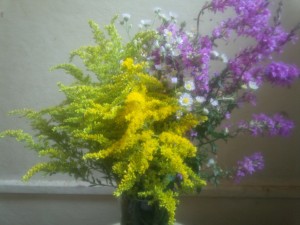 Solidago and symphyotrichum are a perfect couple. You might not recognize their tongue-twisting names, but I guarantee that they are now appearing side by side at locations near you.
Solidago and symphyotrichum are a perfect couple. You might not recognize their tongue-twisting names, but I guarantee that they are now appearing side by side at locations near you.
Those locations might be railroad rights-of-way, country roadsides and other untenanted spaces, including overgrown suburban lots. When hanging out in such information settings, solidago and symphyotrichum usually answer to their better known aliases—goldenrod and New England aster. Florists generally use “solidago” to describe goldenrod, because it sounds exotic and expensive. On the other hand, when those same florists stock tall aster stems, they may call them something like “September weed”, which is descriptive, but not particularly poetic.
Goldenrod is the more prolific of the two and right now it is right in the middle of the annual bloom cycle that begins in late summer and ends around the time of the first hard frosts. Here and there, a few brave gardeners have chosen goldenrod varieties to liven up the middle or rear sections of beds and borders. Smaller solidagos can even be grown in large containers.
Unless you are interested and look very closely, you would never know that the hundred twenty or more goldenrod species are members of the vast daisy or Compositae family. The tall golden plumes, which can rise somewhere between one foot and infinity, are composed of thousands of tiny flowers, loved by butterflies and other pollinators. A field of September or October goldenrod is alive with all kinds of insect life. Various goldenrod species and varieties can be hard to tell apart, as they frequently grow in close proximity and tend to interbreed—helped along by those accommodating pollinators.
Sadly, goldenrod has spent decades, if not a century or so, in horticultural purgatory, falsely convicted of flinging an arsenal of allergens at vulnerable human respiratory systems. The real culprits are unassuming fellow-traveler plants like ragweed. Armed with that knowledge, most of us can enjoy goldenrod, in the wild or in our gardens, with impunity.
To create effective plant pairings with goldenrod, emulate Nature, which combines the yellow plumes with the blue flowers of wild chicory and the blue-purple blooms of those amazing New England asters. Wild chicory has a weedy look, but you can get the same color effect by pairing goldenrod with hardy ageratum or Eupatorium coelestinum, sometimes also called “blue mist flower.” It resembles its relative, annual blue ageratum, which many people use as a bedding plant, except that it has a tall stem—up to three feet. It can stand cheek by jowl with many domesticated goldenrods and it blooms at the same time.
My favorite goldenrod partner is the ‘Monch’ variety of Frikart’s aster or Aster x frikartii ‘Monch’. Unlike the species formerly known as “New England aster”, ‘Monch’ can still be called “aster” due to its European origins. Take comfort in that as you seek it out at garden centers or order from an online vendor. ‘Monch’ bears scores of small, blue daisies with yellow centers, and does not so much grow as billow forth from the earth. The plants reach two to three feet tall and up to eighteen inches wide. The stems may flop a bit, but are easily corralled with stakes or plant supports.
The ‘Monch’ in my yard is so happy that its growth habit is veering into world domination territory. Fortunately, it is easy to divide and transplant.
Goldenrod also mixes well with the russet shades in autumn gardens. The wonderfully-named sneezeweed or helenium is a bit shorter than most goldenrods, and features daisy-like flowers in combinations of yellow, gold and burnt orange. The goldenrod/helenium combo can be paired with tawny-colored chrysanthemums as well. The shorter mums are especially effective at camouflaging the somewhat gangly and ungainly “legs “of the taller plants.
Small space or container gardeners need not be left out of the late season flower party. Breeders have created compact goldenrods to fill those pots or garden corners. I especially like ‘Little Lemon’, which tops out at only 18 inches tall and wide, and has a softer, more rounded look than some of its tall, gold relatives. ‘Little Lemon’ is, as the name suggests, lemon or butter yellow with cloud-like flower panicles. It could be used by itself in a pot or paired in a larger container with an aster of equal size like the blue-purple Aster cordifolius ‘Wood’s Blue’.
Of course any plant that is dubbed “wildflower” is hardy under the most challenging conditions. That kind of tough disposition makes many wildflowers weedy or invasive in a garden setting. Goldenrod is no exception. However, many of the cultivated varieties behave in a more civilized manner. Divide clumps every few years or whenever they seem to be exceeding their allotted spaces. Growing the plants in containers will keep things under control as well, especially if you watch for and grub out unwanted seedlings that may spring up in the vicinity of the container-grown plant.
Goldenrod, not always respected in its Native North America, had to cross the pond to gain acclaim in Europe. Now some Americans are seeing its golden light. If you want to add easy-going autumn beauty to your home landscape, seek out goldenrod at local nurseries and garden centers, or at Bluestone Perennials, 7211 Middle Ridge Road, Madison, OH 44057; (800) 852-5243; www.bluestoneperennials.com. Free catalog.
